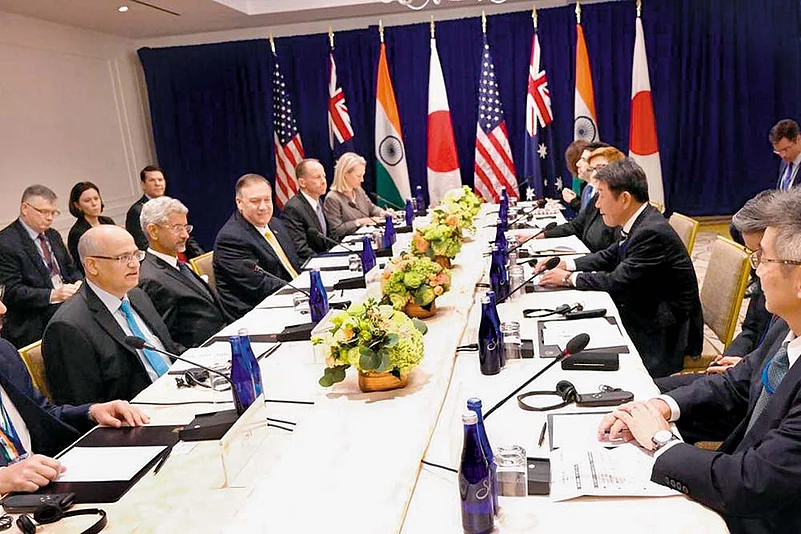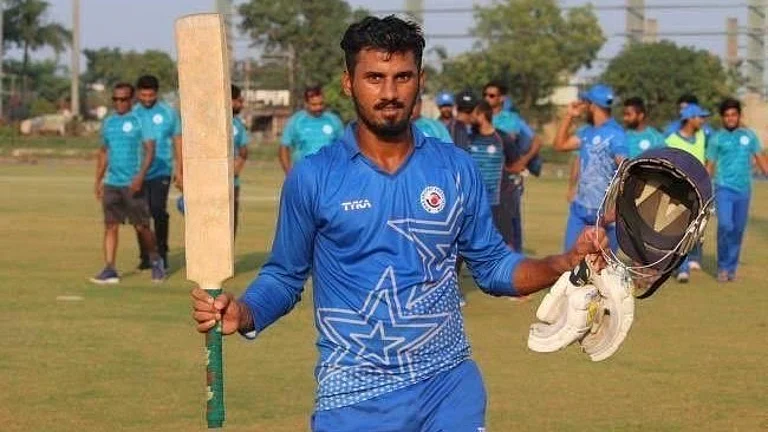The Quad foreign ministers’ meeting in Tokyo on October 6-7 is taking place at a time when there is a continual churn in the waters of the South China Sea, the East China Sea and across the Taiwan Strait, while a blizzard continues to blow at the edge of the Tibetan plateau, along the India-China border in Ladakh. Being held at a time when China’s muscle-flexing has triggered worldwide concern, the meeting takes on a wider significance. The coming together of the US, India, Japan, and Australia in a quadrilateral arrangement, or the Quad, is regarded by China as a move to contain its growing military and political clout in the Indo-Pacific—a term that conflates Pacific and Indian Ocean powers.
The Quad had a spluttering start, but faced with a very real challenge of Chinese assertiveness, the alliance is likely to firm up; if China doesn’t let up on aggression, it may turn into a loose defence arrangement in future.
Whatever hesitation India may have once had about joining the group, ostensibly to checkmate China, has evaporated since the military face-off between the People’s Liberation Army and Indian forces in Ladakh. New Delhi now sees the Quad as an instrument of not just thwarting China but expanding its footprint across Asia. China has been crying hoarse about the Quad from its inception. Reacting to the Tokyo meeting, China’s foreign office spokesman Wang Wenbin dubbed it as an “exclusive clique” out to harm a third country’s interest, referring, obviously, to itself.
The Quad, however, is not a military alliance. “As of now, it is more of a dialogue between four countries in search of a strategy for a peaceful and cooperative order in the Indo-Pacific,’’ says P.S. Raghavan, chairman of the National Security Advisory Board. China is crying wolf to forestall any future move to turn it into a military alliance, Raghavan explains.
What began a few years ago as a meeting of senior officials of the four countries has been upgraded to minister level in 2019, when they met in New York. Summit status might follow too. In short, the Quad is likely to become a factor in the unfolding of the Indo-Pacific defence architecture.
The host for the Tokyo meeting is Japanese foreign minister Toshimitsu Motegi. Besides, India’s S. Jaishankar, US Secretary of State Mike Pompeo and Australian foreign affairs minister Marise Payne will attend. “The foreign ministers are expected to collectively affirm the importance of a free, open and inclusive Indo-Pacific,’’ MEA spokesman Anurag Shrivastava told reporters. The agenda, he said, would be the post-Covid international order and the challenges triggered by the pandemic. Primary amongst those challenges is the aggression by Chinese armed forces—around the South China Sea, East Pacific and Ladakh. It has also flown warplanes into Taiwan’s airspace.
“The Quad seeks to establish, promote and secure Indo-Pacific principles, especially as PRC tactics, aggression, and coercion increase in the region. Recent discussions among the Quad have focused on building cooperation among members on issues, including maritime security, cyber and critical technology, infrastructure, counterterrorism, and the Mekong regional cooperation,’’ David Stilwell, US assistant secretary for East Asian and Pacific Affairs, said at a briefing on Pompeo’s visit to Japan.
The brainchild of former Japanese PM Shinzo Abe, who marked China’s aggression with its growing economic and political clout, the Quad was initiated in 2007. With the support of US vice president Dick Cheney, conservative Australian premier John Howard and India’s Manmohan Singh, Abe organised a meeting of the four democracies to strengthen the cooperative security of the Asia-Pacific region. China protested vehemently, seeing the formation as an anti-China move spearheaded by Abe. The wrangle between the two over the string of islands in the East China Sea that Japan and China claim as the Senkaku Islands and the Diaoyu isles, added sharpness to the first Quad.
But the initiative was short-lived—Howard lost the Australian elections in 2008; his successor, Kevin Rudd, a Mandarin speaker, believed Australia’s future lay in closer cooperation with China. Singh, too, didn’t want to jeopardise fragile ties with China. Abe’s first term was cut short as he was replaced by Yasua Fukuda, who did not pursue Abe’s vision of alliances stretching from the Pacific to the Indian Ocean.
With Shinzo Abe’s return to power, the Quad was revived in 2017, when senior officials met in Manila ahead of the ASEAN summit. Donald Trump’s White House was enthusiastic, while India was initially hesitant after an excellent meeting between PM Narendra Modi and President Xi Jinping in Wuhan. Today, New Delhi regards the Quad as an integral element of its policy to counter the Chinese challenge. Most experts agree that it would give India considerable leverage against China.
Some foreign policy experts disagree. They say since India’s existential threat from China is from across the land border, in Ladakh or Arunachal, the Quad would be of little help. If the direst threat envisaged by India—a two-front war with Pakistan and China—comes to pass, it would be mainly fought on land. So what is the use, they ask, of getting into what may eventually turn into a maritime security alliance. Getting close to an unreliable US will not serve India’s interests, they think.
Vice Admiral Pradeep Kaushiva (retd) disagrees. “The question is not if there is a maritime threat from China but whether India can support its own counter to the threat on land through applying pressure at sea. Almost 80 per cent of China’s energy imports and 40 per cent her total trade passes through the South China Sea, mainly through the Malacca Strait. For an industry-based export economy, this is an immense vulnerability,’’ he contends. China has sought to wrest total control of the South China Sea, Kaushiva explains, precisely because of this vulnerability. Its attempts to create alternate access to the Indian Ocean through the China Pakistan Economic Corridor, establish a naval base at Gwadar and pitch for the Kra Canal project through Thailand, all fall into a pattern.
“The Quad objective is for democratic maritime stakeholders to come together and ensure flow of their trade free from hegemonic Chinese interference. This is fully consistent with India’s maritime interests, as 90 per cent of India’s trade passes through sea, nearly 45 per cent of it through the South China Sea,’’ says Kaushiva. The time has come, he says, for India to decide “whether it has more to gain by joining or less to lose by not joining the Quad.’’
Vice admiral Kaushiva believes that the Quad is an idea whose time has come. But has it? At best, it is a security insurance for the future and a way for New Delhi, with its limited resources, to expand its influence in the Indo-Pacific.


























